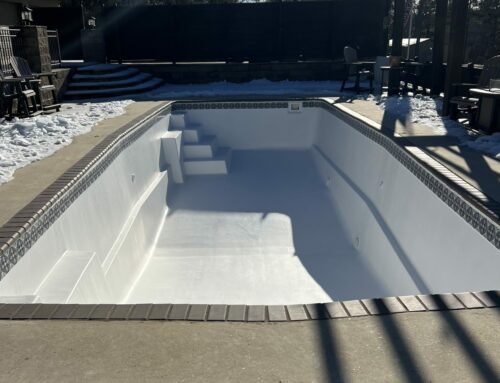Another great season of swimming, splashing, floating, and relaxing in your swimming pool has ended. Now it is time to close the pool for the winter. Properly fiberglass pool winterizing will protect your pool and equipment against freeze damage. Proper winterizing will also ensure a smooth opening in the spring.
Many owners will opt for professional swimming pool winterizing, and this is recommended if you are not 100% confident in your ability to close a fiberglass pool properly. If you chose to continue on your own, there are some things to know.
Winterize at the Right Time
Once the daily temperatures are under 65 degrees, it is time to close it up. If you begin too soon, algae could build up quickly. If you wait too late, you risk damage to the pool and equipment. While Texas fiberglass swimming pools do not have to withstand drastically low temperatures very often, all it takes is one ice storm or one night of ice accumulation to cause damage.
Test Swimming Pool Chemicals
First, test the chemicals. Alkalinity, pH, calcium, and chlorine should all be checked. It is best to start on the chemicals about a week before closing.
Clean and Clear Out Your Fiberglass Pool
Remove all pool accessories. This includes skimmer baskets, cleaners, ladders, steps, and solar blankets. Also, remove handrails.
Give the pool a deep clean, skimming the surface of the water and vacuuming the bottom. Use the brush on the floor and sides.
Lower Power Supplies and Water Level
Turn off the pool’s power supply and remove the on/off trippers from the time clock to prevent the pump from turning on.
Lower the water level. The water level should be below the skimmer basket to prevent the skimmer basket from freezing and breaking.
Drain all equipment to prevent any water within from freezing, expanding, and causing damage. Clear the water from the pool lines using a blower. This can also be an opportunity for pool leak detection. Plug up with expansion plugs. To be extra cautious, you may opt to add pool antifreeze to the pool lines.
Add Shock to Kill Algae and Bacteria
The next step is to add shock to kill bacteria and algaecide to kill algae. Be sure to read the directions on your products as the shock may need to be used a few days before the official closing of the swimming pool. Circulate the chemicals around the pool evenly. If using a chlorine shock, do not add it at the same time as the algaecide.
Cover Your Fiberglass Pool
Lastly, cover the fiberglass swimming pool. With a safety cover, you need to anchor it down with springs or weights. Winter covers do not need to be secured. The cover must be free of holes or tears and must be tight fitting.
Make Any Essential Winter Repairs with Texas Fiberglass Pools
Closing a pool for winter can be a complicated process and must be done properly. One missed step can cause big problems like freezing, cracks and equipment damage.
Done correctly, swimming pool winterizing will make spring opening a breeze.
If you’ve gone through the process and find that your fiberglass pools require equipment repair, our professional team has the knowledge and experience to take care of all your swimming pool needs. Contact us today to schedule your repairs or to learn more about our services.



